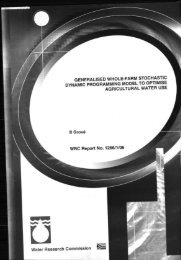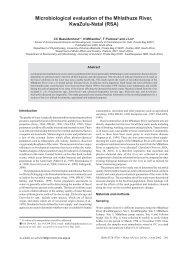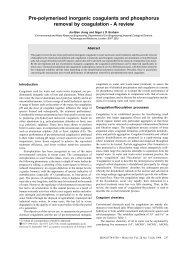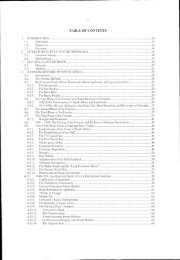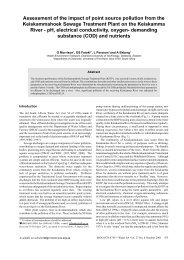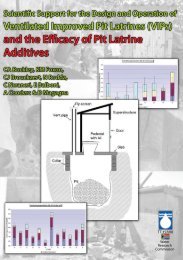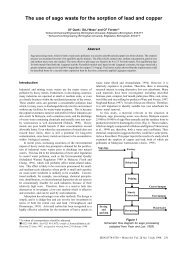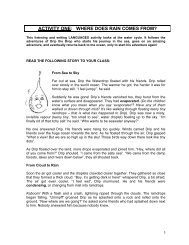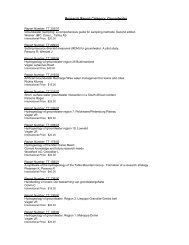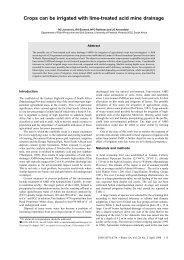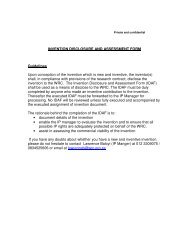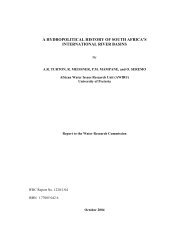A Methods Manual for the Collection, Preparation and Analysis of ...
A Methods Manual for the Collection, Preparation and Analysis of ...
A Methods Manual for the Collection, Preparation and Analysis of ...
Create successful ePaper yourself
Turn your PDF publications into a flip-book with our unique Google optimized e-Paper software.
Occasional filaments should be recorded as <strong>the</strong> corresponding number <strong>of</strong> diatom units. Ifa large number <strong>of</strong> diatom units are found in filaments, a new preparation technique, usinga more aggressive mix <strong>of</strong> oxidising agents, should be considered.In order to eliminate <strong>the</strong> risk <strong>of</strong> including separate fragments <strong>of</strong> broken valves orfrustules, a consistent approach must be decided on be<strong>for</strong>e starting a project. Valvesshould be counted only if approximately three quarters is present, or alternatively brokenvalves may be excluded from <strong>the</strong> count altoge<strong>the</strong>r. Since <strong>the</strong> scale <strong>of</strong> physical damageduring <strong>the</strong> sampling <strong>and</strong> preparation stages is unlikely to be significant, <strong>the</strong> presence <strong>of</strong>many small fragments <strong>of</strong> diatoms may indicate that dead diatoms are being washed infrom upstream sites.A diatom may not be identifiable <strong>for</strong> a number <strong>of</strong> reasons, including <strong>the</strong> presentation <strong>of</strong> agirdle view, <strong>the</strong> presence <strong>of</strong> overlying material obscuring <strong>the</strong> view, or <strong>the</strong> taxon not beingrecognised by <strong>the</strong> analyst. If many valves are obscured, <strong>the</strong>n new slides should beprepared using more dilute suspensions.Some taxa are identifiable from girdle (side) views, ei<strong>the</strong>r because <strong>the</strong> girdle view isparticularly characteristic (e.g. Rhoicosphenia abbreviata) or because <strong>the</strong> girdle view canbe assigned with confidence to a particular taxon by “matching” it with correspondingvalve views <strong>of</strong> taxa found in <strong>the</strong> sample. However, this is not always possible <strong>and</strong>, incases <strong>of</strong> doubt, <strong>the</strong> analyst should record <strong>the</strong> girdle views at <strong>the</strong> lowest level to which <strong>the</strong>ycan be assigned with confidence (e.g. “unidentified Gomphonema sp.”, “unidentifiedpennate girdle view”).This convention should also be applied to o<strong>the</strong>r individuals found on <strong>the</strong> slide but notidentifiable by <strong>the</strong> analyst. A large number <strong>of</strong> such individuals may indicate a problemei<strong>the</strong>r with <strong>the</strong> slide preparation or <strong>the</strong> identification skills <strong>of</strong> <strong>the</strong> analyst.As most diatom indices presume that all taxa in a sample are identified, it isrecommended that not more than five per cent <strong>of</strong> <strong>the</strong> total count should compriseunidentifiable individuals. If a diatom unit cannot be identified <strong>for</strong> any reason,photographs, digital images or detailed drawings should be made. Notes should also betaken <strong>of</strong> <strong>the</strong> shape <strong>and</strong> dimensions <strong>of</strong> <strong>the</strong> diatom unit, striae density <strong>and</strong> arrangement (at<strong>the</strong> centre <strong>and</strong> poles), shape <strong>and</strong> size <strong>of</strong> <strong>the</strong> central area, number <strong>and</strong> position <strong>of</strong> punctae<strong>and</strong> arrangement <strong>of</strong> raphe endings.For some purposes, especially biodiversity studies, it is useful to continue to scan <strong>the</strong>slide after <strong>the</strong> required number <strong>of</strong> diatom units has been counted, <strong>and</strong> any taxaencountered that were not included in <strong>the</strong> count should be identified <strong>and</strong> recorded as“present”.A fur<strong>the</strong>r scan using a medium power magnification (e.g. 400 x) may also be appropriatein order to note any larger taxa (e.g. Gyrosigma spp.) which may be missed at highermagnifications.42



